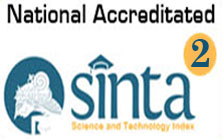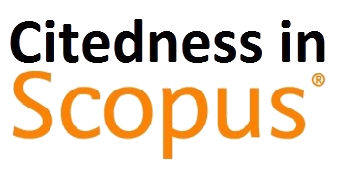The Use of Turmeric (Extracts and Squeeze) to Detect Plaque on Teeth
DOI:
https://doi.org/10.31965/infokes.Vol17.Iss2.276Keywords:
Plaque Index, Turmeric, DisclosingAbstract
Turmeric is one of the original spices and medicinal plants from the Asian region. The benefits of the turmeric plant are good as a complement to cooking spices, herbs/medicines, or to maintain health and beauty. Turmeric can also be used as a coloring agent, such as food coloring agents and dyes for woven fabric crafts. Turmeric plants are easy to find, so turmeric can be used as a substitute for disclosing solution (plaque detection liquid). This turmeric plant is very easy to obtain and does not incur high costs in its management. This study aimed to determine the effectiveness of using turmeric (extract and juice) to detect plaque in teeth in 2019. This type of research uses a quasi-experimental type. The population in this study, namely level 1 military service, amounted to 76 people. The sample used is by using a purposive sampling technique totaling 20 respondents. The results showed an average difference between disclosing solution, 100% turmeric extract, 75% turmeric extract, and 100% turmeric juice. The average disclosing solution was 36.34, 100% turmeric extract 64.50, 75% turmeric extract 79.95, and 100% turmeric juice 90.00. The results of the one-way ANOVA test were sig 0.000 <0.05, meaning that there was an average difference between these variants, from the research results of turmeric extract and turmeric juice could detect plaque but were less effective as a substitute for disclosing solution in plaque detection.
Downloads
References
Alhamda, S. (2011). Status kebersihan gigi dan mulut dengan status karies gigi (kajian pada murid kelompok umur 12 tahun di sekolah dasar negeri kota bukittinggi). Berita kedokteran masyarakat, 27(2), 108-15.
Budiyono & Kaseno. (2004). Studi Penerapan Teknologi Membran Untuk Pemisah Zat Warna Alami dan Ekstrak Kunyit. Yogyakarta.
Cahyati, W. H. (2013). Konsumsi pepaya (Carica papaya) dalam menurunkan debris index. KEMAS: Jurnal Kesehatan Masyarakat, 8(2), 127-136.
Chowdhary, Z., Mohan, R., Sharma, V., Rai, R., & Das, A. (2015). Disclosing Agents In Periodontics: An Update. Journal of dental college azamgarh, 1(1), 103-110.
Datta, D., Kumar, R., Narayanan, A. Selvamary, L., & Sujatha, A. (2017). Disclosing Solutions used in Dentistry. World J Pharm Res. 6(6): 1648-1656.
Fatmasari, D., Musthofa, S., dan Santoso, B. (2014). Efektifitas Buah Bit (Beta Vulgaris) sebagai disclosing solution (Bahan Identifikasi Plak). Odonto: Dental Journal, 1 (2), 6-9.
Fatmawati, D. W. A. (2015). Hubungan biofilm Streptococcus mutans terhadap resiko terjadinya karies gigi. STOMATOGNATIC-Jurnal Kedokteran Gigi, 8(3), 127- 130.
Ghosh, N., Shahnawaz, K., Bose, S. K., Chakrabarti, I., & Ram, R. (2014). A study on prevalence of oral morbidities in an urban slum of Kishanganj district, Bihar, India. IOSR Journal of Dental and Medical Sciences, 13(4), 49-52.
Kementerian Kesehatan R. I. (2018). Hasil Utama RISKESDAS 2018. Jakarta: Balitbangkes Kementerian Kesehatan.
Lemos, J. A., Abranches, J., & Burne, R. A. (2005). Responses of Cariogenic Streptococci To Environmental Stresses. Current issues in molecular biology, 7(1), 95-108.
Mangiri, B. S., Yani, S., & Anitasari, S. (2018). Sari Buah Naga Super merah (Hylocereus costaricensis) Sebagai Pewarna Alami Plak Gigi. Jurnal Material Kedokteran Gigi, 7(1), 28-34.
O’Sullivan, J. M., Jenkinson, H. F., & Cannon, R. D. (2000). Adhesion of Candida albicans to oral streptococci is promoted by selective adsorption of salivary proteins to the streptococcal cell surface. Microbiology, 146(1), 41-48.
Permata, N. G. A. K. R., Wartini, N. M., & Yoga, I. W. G. S. (2015). Pengaruh jenis pelarut terhadap rendemen dan karakteristik ekstrak pewarna dari buah pandan (Pandanus tectorius). Jurnal Rekayasa dan Manajemen Agroindustri, 3(4), 103- 112.
Putri, M.H., Herijulianti, E., Nurjannah, N. (2011). Ilmu Pencegahan Penyakit Jaringan Keras dan Jaringan Pendukung Gigi. Jakarta: EGC.
Rahmawati, I., Said, F., & Hidayati, S. (2015). Perbedaan pH Saliva Antara Sebelum Dan Sesudah Mengkonsumsi Minuman Ringan (Studi pada Siswa Kelas II dan III Madrasah Ibtidaiyah Zam-Zam Zailani Banjarbaru Kalimantan Selatan Tahun 2014). Jurnal Skala Kesehatan, 6(1).
Rezki, S. (2014). Pengaruh pH Plak Terhadap Angka Kebersihan Gigi Dan Angka Karies Gigi Anak Di Klinik Pelayanan Asuhan Poltekkes Pontianak Tahun 2013. ODONTO: Dental Journal, 1(2), 13-18.
Sadiyah, Rizka Auliyatus. (2015). Penggunaan Filtrat Kunyit (Curcuma domestica Val.) Sebagai Pewarna Alternatif Jaringan Tumbuhan Pada Tanaman Melinjo (Gnetum gnemon). BioEdu, 4(1), 765-769.
Sari, A., & Maulidya, A. (2016). Formulasi Sediaan Salep Ekstrak Etanol Rimpang Kunyit (Curcuma longa Linn). Sel Jurnal Penelitian Kesehatan, 3(1), 16-23.
Wahyuni, S. (2016). Pemanfaatan Kunyit (Cucurma Domestica) Sebagai Pewarna Alternatif Preparat Gigi Sapi (Bos indicus)(Gambaran Histologis Preparat Gigi Sapi sebagai Sumber belajar Biologi SMA). Research Report.
Downloads
Published
How to Cite
Issue
Section
License
Copyright (c) 2019 Jurnal Info Kesehatan

This work is licensed under a Creative Commons Attribution-NonCommercial-ShareAlike 4.0 International License.
Copyright notice
Ownership of copyright
The copyright in this website and the material on this website (including without limitation the text, computer code, artwork, photographs, images, music, audio material, video material and audio-visual material on this website) is owned by JURNAL INFO KESEHATAN and its licensors.
Copyright license
JURNAL INFO KESEHATAN grants to you a worldwide non-exclusive royalty-free revocable license to:
- view this website and the material on this website on a computer or mobile device via a web browser;
- copy and store this website and the material on this website in your web browser cache memory; and
- print pages from this website for your use.
- All articles published by JURNAL INFO KESEHATAN are licensed under the Creative Commons Attribution 4.0 International License. This permits anyone to copy, redistribute, remix, transmit and adapt the work provided the original work and source is appropriately cited.
JURNAL INFO KESEHATAN does not grant you any other rights in relation to this website or the material on this website. In other words, all other rights are reserved.
For the avoidance of doubt, you must not adapt, edit, change, transform, publish, republish, distribute, redistribute, broadcast, rebroadcast or show or play in public this website or the material on this website (in any form or media) without appropriately and conspicuously citing the original work and source or JURNAL INFO KESEHATAN prior written permission.
Permissions
You may request permission to use the copyright materials on this website by writing to jurnalinfokesehatan@gmail.com.
Enforcement of copyright
JURNAL INFO KESEHATAN takes the protection of its copyright very seriously.
If JURNAL INFO KESEHATAN discovers that you have used its copyright materials in contravention of the license above, JURNAL INFO KESEHATAN may bring legal proceedings against you seeking monetary damages and an injunction to stop you using those materials. You could also be ordered to pay legal costs.
If you become aware of any use of JURNAL INFO KESEHATAN copyright materials that contravenes or may contravene the license above, please report this by email to jurnalinfokesehatan@gmail.com
Infringing material
If you become aware of any material on the website that you believe infringes your or any other person's copyright, please report this by email to jurnalinfokesehatan@gmail.com.



















